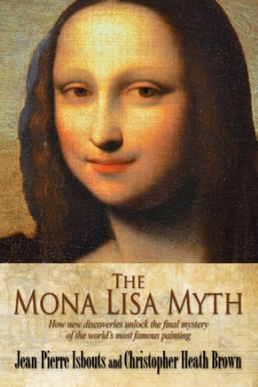
The Mona Lisa is a half-length portrait painting by Italian artist Leonardo da Vinci. Considered an archetypal masterpiece of the Italian Renaissance, it has been described as "the best known, the most visited, the most written about, the most sung about, [and] the most parodied work of art in the world". The painting's novel qualities include the subject's enigmatic expression, monumentality of the composition, the subtle modelling of forms, and the atmospheric illusionism.

Lisa del Giocondo was an Italian noblewoman and member of the Gherardini family of Florence and Tuscany. Her name was given to the Mona Lisa, her portrait commissioned by her husband and painted by Leonardo da Vinci in the Italian Renaissance.
Mona Lisa, Op. 31, is a 1915 opera by the German composer Max von Schillings on a libretto by Beatrice von Dovsky. It was dedicated to the Philosophy Faculty of the University of Heidelberg, where the composer was awarded the title of professor.

Leonardo da Vinci was an Italian Renaissance painter and polymath who achieved legendary fame and iconic status within his own lifetime. His renown primarily rests upon his brilliant achievements as a painter, the Mona Lisa and The Last Supper, being two of the most famous artworks ever created, but also upon his diverse skills as a scientist and inventor. He became so highly valued during his lifetime that the King of France bore him home like a trophy of war, supported him in his old age and, according to legend, cradled his head as he died.
Eduardo de Valfierno, who posed as a marqués (marquis), was supposedly an Argentine con man who allegedly masterminded the theft of the Mona Lisa in 1911. There are serious doubts as to whether or not he existed.
Yves Chaudron was a supposed French master art forger who is alleged to have copied images of Leonardo da Vinci's Mona Lisa as part of Eduardo de Valfierno's famous 1911 Mona Lisa painting theft. In reality he may be a fictional character created by Karl Decker for an article that ran in a 1932 issue of the Saturday Evening Post, and passed off as a real person. There is also very little evidence that Valfierno actually existed, or if he did, that he was involved in the theft of the Mona Lisa at all.

The Isleworth Mona Lisa is an early 16th-century oil on canvas painting depicting the same subject as Leonardo da Vinci's Mona Lisa, though with the subject depicted as being a younger age. The painting is thought to have been brought from Italy to England in the 1780s, and came into public view in 1913 when the English connoisseur Hugh Blaker acquired it from a manor house in Somerset, where it was thought to have been hanging for over a century. The painting would eventually adopt its unofficial name of Isleworth Mona Lisa from Blaker's studio being in Isleworth, West London. Since the 1910s, experts in various fields, as well as the collectors who have acquired ownership of the painting, have asserted that the major elements of the painting are the work of Leonardo himself, as an earlier version of the Mona Lisa.
Jucundus, is a given name or surname of several people and of similar Christian saints. It may refer to:

I, Mona Lisa is a historical novel by Jeanne Kalogridis about Lisa Gherardini, the model for Leonardo da Vinci's painting Mona Lisa. Lisa is portrayed as a young Italian woman who learns about the murder of Giuliano de' Medici, the brother of Lorenzo de' Medici in the Pazzi conspiracy. Guiliano's murder casts a shadow, especially as one of the killers has not been found. She later falls in love with Giuliano's namesake, Lorenzo's son Giuliano in the aftermath of Girolamo Savonarola's uprising in the late 15th century.

The 16th-century portrait Mona Lisa, or La Gioconda, painted in oil on a poplar panel by Leonardo da Vinci, has been the subject of a considerable deal of speculation.
Agostino Vespucci was a Florentine chancellery official, clerk, and assistant to Niccolò Machiavelli, among others. He is most well known for helping to confirm the subject of Leonardo da Vinci's Mona Lisa as Lisa del Giocondo, but is also the author of a number of surviving letters and manuscripts.

Gian Giacomo Caprotti da Oreno, better known as Salaì was an Italian artist and pupil of Leonardo da Vinci from 1490 to 1518. Salaì entered Leonardo's household at the age of ten. He created paintings under the name of Andrea Salaì. He was described as one of Leonardo's students and lifelong companion and servant and was the model for Leonardo's St. John the Baptist,Bacchus and Angelo incarnato.
Leonardo da Vinci's Mona Lisa is one of the most recognizable and famous works of art in the world, and also one of the most replicated and reinterpreted. Mona Lisa replicas were already being painted during Leonardo's lifetime by his own students and contemporaries. Some are claimed to be the work of Leonardo himself, and remain disputed by scholars. Prominent 20th-century artists such as Marcel Duchamp and Salvador Dalí have also produced derivative works, manipulating Mona Lisa's image to suit their own aesthetic. Replicating Renaissance masterpieces continues to be a way for aspiring artists to perfect their painting techniques and prove their skills.

The Smile (2008) is a Young Adult novel by Donna Jo Napoli that details a slice of the life of Monna Elisabetta, better known as the Mona Lisa. Some historical figures enter the plot, including Leonardo da Vinci and members of the famous Medici family. Set in Renaissance Florence, it follows Elisabetta's life up to the moment she models for da Vinci's painting, and suggests the secret behind her famous smile.
Jean-Pierre Isbouts is a professor in the Social Sciences PhD program of Fielding Graduate University in Santa Barbara, California, and an archaeologist, author, screenwriter, director, and producer of works addressing various historical periods, particularly the time period of Jesus and that of Renaissance and post-Renaissance art.

The two–Mona Lisa theory is a longstanding theory proposed by various historians, art experts, and others that Leonardo da Vinci painted two versions of the Mona Lisa. Several of these experts have further concluded that examination of historical documents indicates that one version was painted several years before the second.

The Mona Lisa Myth is a multimedia project consisting of a 2013 book and a 2014 documentary film, produced in tandem by Renaissance scholar and art historian Jean-Pierre Isbouts, with physician and art collecter Christopher Heath Brown as co-author of the book and as a producer of the documentary, the latter with narration by Morgan Freeman. The book and film each examine the history of the Mona Lisa, and the longstanding theory that the Isleworth Mona Lisa is an earlier version of the same painting, also by Leonardo da Vinci.
Vincent Delieuvin is a French author and art historian specializing in the work of Leonardo da Vinci, and in Italian paintings of the sixteenth century, generally. Since 2006, he has worked as a heritage curator at the Louvre museum.

Hermitage Mona Lisa is a painting on canvas, which was made by an unknown painter in the mid-16th century and is located in the Hermitage Museum of Saint Peterburg. It was transferred from the Antikvariat All-Union Association and entered the Hermitage in 1931.

There are two theories revolving around the Mona Lisa by Leonardo da Vinci which postulate that the subject of the painting was actually a man. Leonardo is known for having a number of conspiracy theories formed around his life and his art, and the Mona Lisa has attracted an especially high number of these. Many of the theories surrounding the Mona Lisa stem from how art historians have still not conclusively determined the sitter's identity. The commonly accepted explanation is that she was Lisa Gherardini, the wife of a silk merchant from Florence named Francesco del Giocondo; however, without irrefutable proof there are still an array of alternative theories. While many theories uphold the assumption that the model for the Mona Lisa was a woman, there are two theories which propose that the sitter may have been a man in drag. One theory is that the model for the portrait was Leonardo's longtime apprentice and suspected lover, Gian Giacomo Caprotti, also known by the nickname Salai. The other theory is that the Mona Lisa is a self-portrait of Leonardo as a woman. Neither of these theories is well received by most art historians.










